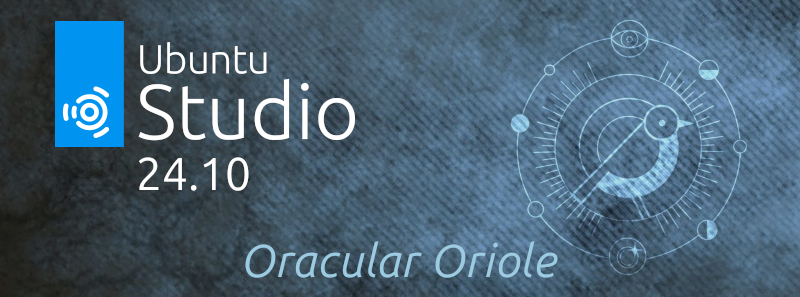
THIS PAGE IS SUBJECT TO RAPID CHANGES AS BUGS ARE FOUND AND FIXED.
Ubuntu Studio shares some of the same desktop features as Kubuntu. Please see Kubuntu release notes for additional information.
Getting Ubuntu Studio 24.10
Download a Disk Image
Bootable images for standard PCs/laptops
Instructions for burning the image to a USB flash drive can be found on the Burning ISO Howto. NOTE: This ISO image exceeds 4.0GB and might not write correctly to a DVD. We recommend USB flash drives be used as installation media of 8GB or greater.
Check SHA256SUM for the downloaded ISO
It is recommended to check your image file so your installation goes smoothly. Compare your SHA256 checksum with the correct ones found alongside the images.
Upgrading to Ubuntu Studio 24.10
Upgrades to 24.10 from 24.04 LTS are usually enabled within two weeks after release. If you have enabled upgrades to regular releases, you should receive a notification if you are running Ubuntu Studio 24.04 LTS that an upgrade is available. If you do not receive a notification about a month after the release of Ubuntu Studio 24.10, make sure you have plasma-distro-release-notifier installed.
To upgrade automatically, click on the notification icon in your system tray.
To manually upgrade, ensure the package press Alt+Space to invoke Krunner, and type the following:
do-release-upgrade -m desktop -f DistUpgradeViewKDE
Alternatively, you can do this from the Konsole terminal:
do-release-upgrade -m desktop
If you wish to upgrade early, simply add a -d after do-release-upgrade. Note that this is not supported and could break your system.
Changes for this release
(compared to 24.04 LTS Noble Numbat)
This release includes Plasma 6.1 from KDE. This is a major upgrade and things might have moved from where you expect them.
We have switched from linux-lowlatency to linux-generic for our kernel with special boot options to make it run in a low latency mode in anticipation of the eventual deprecation of linux-lowlatency. These boot options can be adjusted from Ubuntu Studio Audio Configuration.
Ubuntu Studio Audio Configuration no longer has the option to switch to the legacy PulseAudio/JACK configuration as this configuration is now completely deprecated and unsupported. JACK can still be used by itself by disabling the PipeWire-JACK module and running QJackCtl to start and stop-jack via this utility.
A Minimal Install option is now included in the ISO image.
Ubuntu Studio has switched from Materia to Orchis for its default theme.
Audio
- PipeWire upgraded to 1.2.4
- lsp-plugins upgraded to 1.2.16
- Audacity upgraded to 3.6.1
- Ardour upgraded to 8.6.0
- Carla upgraded to 2.5.9
Graphics
- digiKam upgraded to 8.4.0
- Darktable upgraded to 4.8.0
- gimp upgraded to 2.10.38
- krita upgraded to 5.2.3
Video
- OBS Studio upgraded to 30.2.3
- Blender upgraded to 4.2.1
- KDEnlive upgraded to 24.08.1
- Freeshow upgraded to 1.2.8
Default Desktop Environment
- KDE Plasma Desktop upgraded to 6.1.5
- KDE Frameworks upgraded to 6.6.0
- Qt upgraded to 6.6.2
- KDE Gear upgraded to 24.08.1
Current Version of Main Multimedia Packages
- Blender v4.2.1
- KDEnlive v24.08.1
- Krita v5.2.3
- Gimp v2.10.38
- Ardour v8.6.0
- Scribus v1.6.2
- Darktable v4.8.0
- Inkscape v1.2.2
- Carla v2.5.9
- OBS Studio v30.2.3
- MyPaint v2.0.1
- Audacity v3.6.1
A note about TLP (Tuned for Linux Power)
Many people prefer using tlp for power management on Linux-based laptops, usually after following many guides online. However, installing tlp will result in a conflict against power-profiles-daemon, which is installed in Ubuntu Studio.
power-profiles-daemon is required by the KDE Plasma desktop environment and is the preferred choice for power management on Ubuntu Studio. Uninstalling it will result in uninstallation of ubuntustudio-desktop-core which may result in the auto-removal of the entire desktop environment.
For power management in Ubuntu Studio, please do not attempt to install tlp as we cannot support it. Instead, use the built-in Power Profiles, which are in the Power Management menu in the system tray.
For fine-tuning of CPU power usage, cpupowergui is also installed by default.
Known Problems
- The installer was supposed to be able to keep the screen from locking, but this will still happen after 15 minutes. Please keep the screen active during installation. As a workaround if you know you will be keeping your machine unattended during installation, press Alt-Space to invoke Krunner (this even works from the Install Ubuntu Studio versus the Try Ubuntu Studio live environment) and type “System Settings”. From there, search for “Screen Locking” and deactivate “Lock automatically after…”.
Another possible workaround is to click on “Switch User” and then re-login as “Live User” without a password if this happens. - You will be prompted, upon first login of any new user, to reboot to apply proper audio configurations for audio production. This is intentional and is a workaround for the installer’s inability to configure the first user as part of the “audio” group or for new users to be added to the audio group automatically.
- Ubuntu Studio uses the same KDE Plasma desktop environment as the official Kubuntu release, and thus, may be affected by some of the same issues. This is also true of the core packages of Ubuntu. You can see their release notes here (Kubuntu) and here (Ubuntu).
Support
Ubuntu Studio 24.10 (Oracular Oriole) will be supported for 9 months until July 2025.
Contact Us
Ways to contact the Ubuntu Studio Team are listed here

